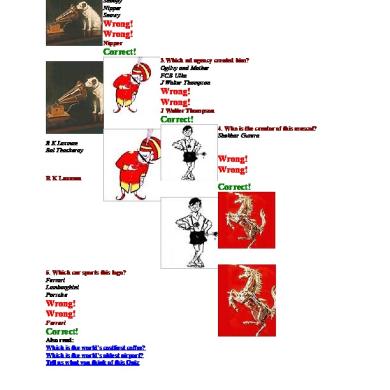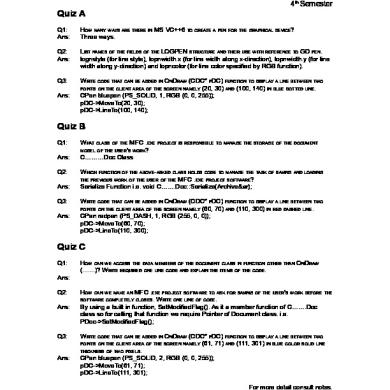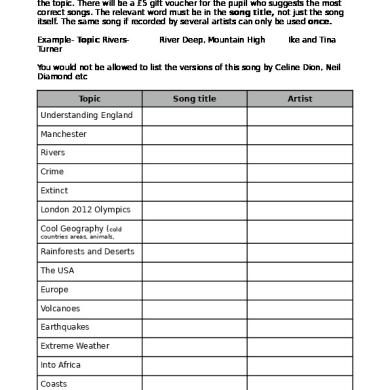(11)answers To Quiz 11.docx
This document was uploaded by user and they confirmed that they have the permission to share it. If you are author or own the copyright of this book, please report to us by using this DMCA report form. Report DMCA
Overview
Download & View (11)answers To Quiz 11.docx as PDF for free.
More details
- Words: 840
- Pages: 4
Answers to Quiz 11 1. What is an inflationary period and how does it differ from a deflationary period? Answer.
An inflationary period is a period of rising prices. The industrialized economies have been experiencing an inflationary period over the last 60 years.
A deflationary period is a period of falling prices. Some industrialized economies in the 19th century had experience deflationary periods.
2. Give two reasons why it is important for policymakers to keep the price level stable over time (or to keep inflation low). Answer.
Keeping inflation low is the primary macroeconomic policy goal for central banks around the world.
One reason is to maintain the purchasing power of money (or the value of money).
Another reason is that low inflation does not significantly enter into the decisions of households and firms, and thus they can make better economic decisions (like savings decisions, investment decisions, consumption decisions, production decisions, and so on).
Note that high inflation creates confusion and complicate the economic decisions that people need to make.
3. Draw the demand and supply curves in the monetary sector of the economy and show what happens to the equilibrium price level when people hold less money. Answer.
With people holding less money, the demand for money is declining.
This shifts the demand curve for money to the left which creates an ESM at point A.
ESM turns into EDG.
In response to EDG, the price level goes up (from P1* to P2*) and the value of money goes down from (value of money)1* to (value of money)2* at the new equilibrium or point B. 1
4. If P = 10 index points, Y = $10,000, and M = $2,500, then V = 40.
5. Let velocity be relatively constant over time. If the economy is growing at 10% per year, what should the central bank do to keep the price level stable? Answer.
With velocity stable, we have %ΔV = 0. Also, %ΔY = 10%. Then, the central bank should increase money supply by 10% in order to keep the inflation rate stable (that is, %ΔP = 0). %ΔM + %ΔV = %ΔP + %ΔY %ΔM + 0 = 0 + 10%
or
%ΔM = 10%
6. Use the equation of exchange to clearly explain why money is neutral in the long-run. Answer.
According to the money neutrality proposition, changes in money supply affect only nominal variables and not real variables in the long-run. That is, M. V = P. Y
An increase in money supply increases only the price level (P) and leaves real GDP (Y) unchanged in the long-run. Note that velocity is relatively constant over time and is thus unaffected by the change in money supply. 2
7. Explain the process through which an expansionary monetary supply affects the price level and value of money. Answer.
The process can be summarized as follows: MS
ESM
EDG
P
the value of money
8. List three ways the government can finance its budget deficit. Which method causes inflation? Answer.
The three ways for the government to finance its budget deficit are: o raising taxes; o borrowing from the public (i.e., selling government bonds to the public); and o printing money (which causes inflation).
9. What is inflation tax? Who is affected by the inflation tax and why? Answer.
Central banks in some countries print money to pay for government spending above the government tax revenue (budget deficit).
With this in mind, we define inflation tax as the revenue the government raises by creating (or printing) money to finance budget deficit.
The inflation tax adversely affects everyone who holds money (since money loses its purchasing power due to rising prices).
Note that an inflation tax is a less clear form of taxation than the standard forms of taxation (like income tax, sales tax, etc.)
3
10. Clearly explain how a 10% increase in money supply would affect the nominal interest rate, real interest rate and inflation rate in the long-run (assuming that velocity is relatively constant over time, and output grows by 3% per year). Answer.
With velocity stable, we have %ΔV = 0. Also, %ΔY = 3%. When the central bank increases money supply by 10%, inflation increases by 7%. That is, %ΔM + %ΔV = %ΔP + %ΔY 10% + 0 = %ΔP + 3% %ΔP = 7%
Recall that:
Nominal interest rate = real interest rate + inflation rate 7% = 0 + 7%
That is, with the inflation rate at 7%, the nominal interest rate increases by 7%.
Note that the real interest rate is unaffected by the change in money supply in the longrun. This is consistent with the money neutrality proposition that changes in money supply affect only nominal variables and not real variables in the long-run.
Also, consistent with the Fisher effect, there is a one-for-one relationship between the nominal interest rate and inflation in the long-run.
4
An inflationary period is a period of rising prices. The industrialized economies have been experiencing an inflationary period over the last 60 years.
A deflationary period is a period of falling prices. Some industrialized economies in the 19th century had experience deflationary periods.
2. Give two reasons why it is important for policymakers to keep the price level stable over time (or to keep inflation low). Answer.
Keeping inflation low is the primary macroeconomic policy goal for central banks around the world.
One reason is to maintain the purchasing power of money (or the value of money).
Another reason is that low inflation does not significantly enter into the decisions of households and firms, and thus they can make better economic decisions (like savings decisions, investment decisions, consumption decisions, production decisions, and so on).
Note that high inflation creates confusion and complicate the economic decisions that people need to make.
3. Draw the demand and supply curves in the monetary sector of the economy and show what happens to the equilibrium price level when people hold less money. Answer.
With people holding less money, the demand for money is declining.
This shifts the demand curve for money to the left which creates an ESM at point A.
ESM turns into EDG.
In response to EDG, the price level goes up (from P1* to P2*) and the value of money goes down from (value of money)1* to (value of money)2* at the new equilibrium or point B. 1
4. If P = 10 index points, Y = $10,000, and M = $2,500, then V = 40.
5. Let velocity be relatively constant over time. If the economy is growing at 10% per year, what should the central bank do to keep the price level stable? Answer.
With velocity stable, we have %ΔV = 0. Also, %ΔY = 10%. Then, the central bank should increase money supply by 10% in order to keep the inflation rate stable (that is, %ΔP = 0). %ΔM + %ΔV = %ΔP + %ΔY %ΔM + 0 = 0 + 10%
or
%ΔM = 10%
6. Use the equation of exchange to clearly explain why money is neutral in the long-run. Answer.
According to the money neutrality proposition, changes in money supply affect only nominal variables and not real variables in the long-run. That is, M. V = P. Y
An increase in money supply increases only the price level (P) and leaves real GDP (Y) unchanged in the long-run. Note that velocity is relatively constant over time and is thus unaffected by the change in money supply. 2
7. Explain the process through which an expansionary monetary supply affects the price level and value of money. Answer.
The process can be summarized as follows: MS
ESM
EDG
P
the value of money
8. List three ways the government can finance its budget deficit. Which method causes inflation? Answer.
The three ways for the government to finance its budget deficit are: o raising taxes; o borrowing from the public (i.e., selling government bonds to the public); and o printing money (which causes inflation).
9. What is inflation tax? Who is affected by the inflation tax and why? Answer.
Central banks in some countries print money to pay for government spending above the government tax revenue (budget deficit).
With this in mind, we define inflation tax as the revenue the government raises by creating (or printing) money to finance budget deficit.
The inflation tax adversely affects everyone who holds money (since money loses its purchasing power due to rising prices).
Note that an inflation tax is a less clear form of taxation than the standard forms of taxation (like income tax, sales tax, etc.)
3
10. Clearly explain how a 10% increase in money supply would affect the nominal interest rate, real interest rate and inflation rate in the long-run (assuming that velocity is relatively constant over time, and output grows by 3% per year). Answer.
With velocity stable, we have %ΔV = 0. Also, %ΔY = 3%. When the central bank increases money supply by 10%, inflation increases by 7%. That is, %ΔM + %ΔV = %ΔP + %ΔY 10% + 0 = %ΔP + 3% %ΔP = 7%
Recall that:
Nominal interest rate = real interest rate + inflation rate 7% = 0 + 7%
That is, with the inflation rate at 7%, the nominal interest rate increases by 7%.
Note that the real interest rate is unaffected by the change in money supply in the longrun. This is consistent with the money neutrality proposition that changes in money supply affect only nominal variables and not real variables in the long-run.
Also, consistent with the Fisher effect, there is a one-for-one relationship between the nominal interest rate and inflation in the long-run.
4
Related Documents

Answers To Quiz 2
December 2019 22
Quiz
November 2019 39
Quiz
May 2020 34
Quiz
November 2019 35
Quiz
May 2020 33
Quiz
October 2019 45More Documents from ""

(12)answers To Quiz 12.doc
November 2019 14
(9)answers To Quiz 9.doc
November 2019 19
(13)answers To Quiz 13.doc
November 2019 16
(11)answers To Quiz 11.docx
November 2019 13
(10)answers To Quiz 10.doc
November 2019 13